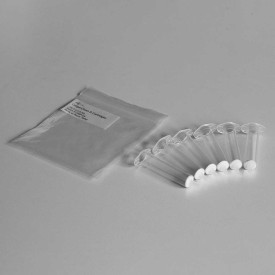LudgerSep C2 anion exchange HPLC Column
LudgerSep™C2 HPLC columns contain particles with a macroporous polymeric anion exchange coating optimized for anion exchange chromatography of complex glycan mixtures. The LudgerSep strong anion exchange column is used for determining the charge profile of 2-AB and 2-AA labelled glycans as part of biopharmaceutical QC procedures.
Product specification
Application: Charged-based analysis and purification by HPLC of LudgerTag™ fluorophore and UV-chromophore labeled glycans.
Description: LudgerSep™C2 HPLC columns contain particles with a macroporous polymeric anion exchange coating optimized for anion exchange chromatography of complex glycan mixtures.
Particles: 8 m polystyrene divinyl benzene with a stable quaternized polyethylene imine coating
| Cat # | Diameter x Length | Column Volume |
|---|---|---|
| LS-C2-4.6x50 | 4.6 x 50 mm | 0.83 ml |
| LS-C2-4.6x150 | 4.6 x 150 mm | 2.49 ml |
Column Tube: Stainless steel
Flow Rates: Typical flow rates = 0.3 – 2.0 ml/min. Maximum flow rate = 4 ml/min
Pressure: Pressure should not exceed 300psi (207bar)
pH Range: 1 – 13
Temperature: Typical operating temperature = 30oC, but increasing the temperature may improve resolution for some samples. Maximum temperature range = 10 - 60oC.
Solvents: Typical solvent systems for glycan analysis include gradients of aqueous buffers containing acetonitrile and either ammonium formate, (cat. No. LS-N-BUFFX40) ammonium acetate, or sodium acetate salts. Avoid strong oxidants and anionic detergents.
Column Protection: Filter all solvents to 0.2 µm and degas using either helium sparging or vacuum degassing. Filter all samples using a 0.2 µm filter membrane before loading onto the column. Install a good quality in-line filter between the sample injector and the column. Please call us for advice on the most suitable sample and in-line filters to use.
Amount of Sample: The maximum amount of glycan sample that can be loaded on the column depends on the number and type of glycan components as well as the nature of any non-glycan material. The typical range for successful analytical runs is 1pmol - 1 nmol per sample peak and up to 200 nmol of total glycans.
Suitable Samples: Suitable samples include glycans labelled with the following LudgerTag labels :
- 2-AA (2-aminobenzoic acid),
- 2-AB (2-aminobenzamide exchange)
Sample: Filter samples to 0.2 µm then dry using a centrifugal evaporator.
Preparation: Re-dissolve in 5 - 50 µl of the starting buffer (i.e. the solvent mixture used at the very start of the HPLC gradient) then inject.
Sample Detection: Either fluorescence or UV-absorbance depending on the dye used (see the appropriate LudgerTag instruction guide).
Handling: Ensure that any glass, plasticware or solvents used are free of glycosidases and environmental carbohydrates. Use powder-free gloves for all sample handling procedures and avoid contamination with environmental carbohydrate.
Safety: Please read the Material Safety Data Sheets (MSDS's) for all chemicals used. All processes involving labelling reagents should be performed using appropriate personal safety protection - eyeglasses, chemically resistant gloves (e.g. nitrile), etc. - and where appropriate in a laboratory fume cupboard
For research use only. Not for human or drug use
HPLC System Requirements
LudgerSep™ C2 columns can be used with any HPLC pumping system capable of delivering accurate gradients at a flow rate of 0.3 to 2.0 ml/min. In general, systems which mix eluants at high pressure (after the pump head) have lower dead volumes and supply more accurate gradients that are appropriate at the flow rate needed for LudgerSep columns. Low dead volume injectors should be used (Rheodyne 7125 / 9125 or similar are recommended). The loop size to be used depends on the separation mode and amount of sample. For analytical runs it is desirable to minimise the sample volume and, typically, a 10 µl loop is used with sample injection volumes of 1 to 5 µl (partial fill) or > 10 µl (complete fill). For charge mode separations, generally, anionic glycans which are retained by the column (and are therefore effectively concentrated on the column) are reasonably tolerant of larger injection volumes whereas non-anionic glycans are not retained by the column matrix and will elute in a volume proportional to the injection volume.
A fluorescence detector is required (µex = 330 nm, µem=420 nm) for LudgerTag 2-AB or 2-AA labelled oligosaccharides. This could be either a filter or monochromator type. Fluorescence filters for OPA-peptide analysis work well and, typically, with these glycan peaks eluting from the LudgerSep C2 column containing 2 - 5 pmol of 2-AB or 2-AA labelled glycans can be detected with good signal-to-noise.
LudgerTag™ 2-AB and 2-AA labelled glycans can also be detected using UV (254 nm) with an approximately 10 to 100 fold reduction in sensitivity compared to fluorescence. Unlabeled oligosaccharides, particularly those bearing N-acyl amino groups, can be detected at 190 - 210 nm. down to the 1 nmol level. However, the absorption of the buffers and solvents becomes a problem when using UV detection, especially at short wavelengths.



 Product guide
Product guide








